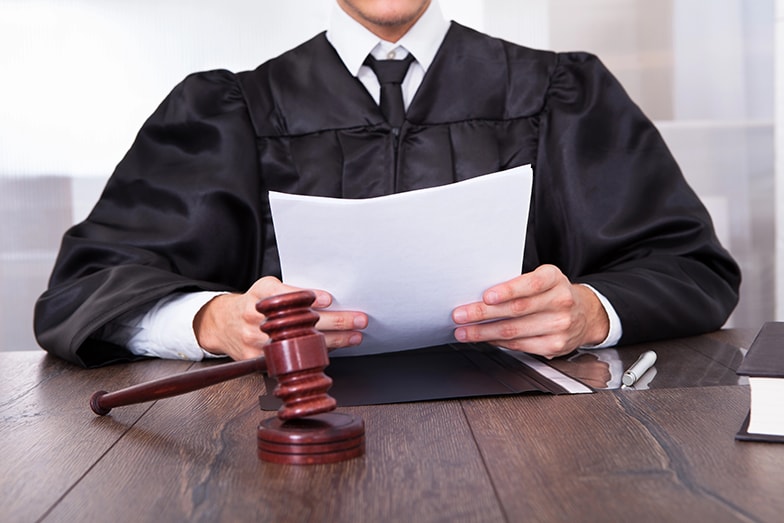By: Aram Simovonian, Lima Lee Simovonian LLP1
It seems to me it would be a shameful violation of the spirit of the Act of Assembly, if we refused to allow an amendment rendered necessary by the mere mistake of a name.
– Woodman v The Town Council of Moncton, 3 P. & B., 338.
Anybody in the real world […] reading the writ would immediately say “‘John Doe’ is not I”. But that driver reading the writ would immediately and without hesitation say “I am the ‘John Doe’ sued, I was driving the vehicle at the place and time as alleged but that, of course, is not my real name”.
– Jackson v Baubella, 1972 CanLII 978 (BC CA)
Part I
Introduction
Sometimes, you don’t know who to sue. But a decision must be made quickly because the bright red line of a limitation period is never too far away. Thankfully, the law allows for correction of (certain) mistakes; more specifically, mistakes in name. This saving grace is described as the “doctrine of misnomer”.
The term “misnomer” is defined as a “mistake in name; the giving an incorrect name to a person in a pleading, deed, or other instrument”.2 John Doe, Jane Doe, and Richard Roe (and many others) are but a few popular mistakes in name. These fictitious characters have felt the blunt force of litigation since time immemorial.
Misnomers, of course, need correcting.3 The Does and Roes are garbed in the characteristics of real people, under the costume of an incorrect name.4 Once the costume is removed, and the identity of the real person is revealed, the misnomer is freed from the claim’s custody, and replaced by the correct name of the party captured by the pseudonym.
The crux of a misnomer is this: litigants unaware of the correct legal name of a party may assign to it an incorrect placeholder name, and at a time when the litigant becomes aware of the correct legal name, the litigant may move before the court to seek leave to substitute the incorrect name with the correct name. In other words, a misnomer is a misnaming; it is not an addition of a new party, rather, it is for the insertion of a name into the action to correct (or substitute) a name for a descriptor or for that of another named party.
Pseudonyms are widely used in product liability claims, particularly subrogation actions.5 These actions are often brought near the end of a limitation period (after the insurer completes its investigation),6 and tend to include numerous defendants, such as contractors, engineers, architects, sub-contractors, manufacturers, suppliers, designers, and the list goes on. Oftentimes, insurers (and their lawyers) are unaware of the identity of each particular defendant, and in that regard, they use pseudonyms such as “John Doe Installer” or “John Doe Manufacturer” to sue the unknown defendant within the required limitation period.
Sooner or later, the identity of the unknown defendant is revealed, and the litigant is able to rely on the doctrine of misnomer to correct the name of the incorrectly named party.
Part II
Ontario’s Limitations Act, 2002, S.O. 2002, c. 24, Sched B.
Ontario’s current limitations statute, the Limitations Act, 2002, came into effect on January 1, 2004. Its purpose was to “balance the right of claimants to sue with the right of defendants to have some certainty and finality in managing their affairs”.7 The Limitations Act established the basic, and well known, 2-year limitation period (and the ultimate 15-year limitation period).8
The Limitations Act, by s.20(1), executed the common law doctrine of “special circumstances”.9 In summary, the special circumstances doctrine was used on motions to amend pleadings after the expiry of a limitation period. This doctrine allowed the Court, in its discretion, to extend an expired limitation period and add and/or substitute a party in those cases where special circumstances exists, unless the change would cause prejudice that could not be compensated for by costs or an adjournment.10 This, as it stands, is a bright line rule.
There is relief from the strictures of the statute. The relief is found in s. 21(2) and notes that the two-year limitation period does not prevent the correction of a misnaming or misdescription of a party. Consequently, s.21(2) allows litigants to correct the name of an incorrectly named party even after the expiry of a limitation period.11
Importantly, the correction of a misnomer is not akin to a pleading amendment.12 A party is not seeking to amend a pleading pursuant to Rule 26.02 when asking to apply the doctrine of misnomer. Rather, and pursuant to Rule 5.04(2), the title of the proceeding is corrected with no changes to the pleadings having to be made.13 The court’s ability to correct misnomers is found in Rule 5.04(2) of the Rules of Civil Procedure; this rule allows a party, at any stage, to correct the name of a party incorrectly named, unless there is evidence of non-compensable prejudice. The court’s power to grant leave to correct the misnomer is discretionary and driven by the principles of fairness and judicial efficiency.14
This paper provides an overview of the historically narrow application of the misnomer doctrine. We then look at the shift in jurisprudence to a broader brush stroke as to what is a permissible misnomer correction.
Part III
Classic Misnomer
Historically, the doctrine of misnomer was applied to correct names which contain minor spelling errors only when the claim was personally served on the misnamed party.15 The doctrine’s application was narrow: for example, courts denied name correction when (i) the party seeking the correction failed to make effort to discover the identity of the correct defendant, and when (i) a party makes a blunt mistake in the name (i.e., suing party “A”, when they ought to have sued party “B”).
An example of a blunt mistake in name is found in Board of Commissioners of Police of Corporation of Township of London v Western Freight Lines Ltd. and Ulch.16 In this case, the court refused to grant a misnomer correction of a deliberate but mistaken choice of the plaintiff’s name. The plaintiff sued two defendants. After the action was commenced, the plaintiff’s lawyers learned that the correct plaintiff is not the “Board of Commissioners of Police of Corporation of Township of London,” but rather, the “Corporation of the Township of London.” After the limitation period expired, the plaintiff brought a motion to correct this irregularity; the defendants brought a cross-motion to strike the action as no cause of action vested in the named plaintiff.
At first instance, Judge McCallum made the following findings: (i) the mistake in the plaintiff’s name was a misnomer and/or irregularity; (ii) the defendants were not misled, or substantially injured by the mistake; and (iii) the action is not a nullity and the plaintiff may amend the style of cause to correct the plaintiff’s name. The defendants’ motion was dismissed. Judge McCallum was too forward thinking for the time; the defendant appealed, and the majority allowed the appeal.
Laidlaw J.A., for the majority, found that the plaintiff’s lawyers knew of the two separate corporate entities and made a decision to sue in the name of the incorrect corporate entity. In that regard, there was no “mistake” in the name, and no misnomer requiring correction. The majority found it improper for the plaintiff to substitute an entirely different corporate party for the entity in whose name the action was commenced.17
The minority reason was delivered by Gibson J.A.; the minority, like Judge McCallum, was too forward thinking for that time. Gibson J.A.’s analysis focused on whether the defendants were misled and/or prejudiced by the plaintiff’s misnaming. The minority found no misleading or prejudice and rather found that the defendants, at all times, knew precisely of the claim that was made against them. The plaintiff’s proposed amendment did not seek to establish a new cause of action, but was simply an amendment as to the owner of the vehicle (the correct plaintiff).
Consider the following: the plaintiff, in Jackson v Bubela,18 was injured in a car accident. A claim was started against the known owner of the offending vehicle. The identity of the driver was unknown. The plaintiff’s lawyers made effort to discover the identity of the driver, albeit unsuccessfully. In the face of a soon-to-expire limitation period, the plaintiff had no option but to commence her claim, and used the pseudonym “John Doe” in place of the unknown driver. Sometime after the claim was issued, the plaintiff discovered that the unknown driver was the brother of the owner of the car; the unknown driver’s name was revealed to be Wallace Bubela. The plaintiff brought a motion to correct the misnomer.
The plaintiff failed at first instance. The court found that the amendment may be permissible if it simply a correction of a misnomer (i.e., a correction of a “classic” mistake in name, such as an error in spelling); if however, it is an addition or substitution of a party, the amendment will not be granted as it would deprive the party sought to be added the protection offered by the statute of limitation.19 The court concluded that: “[the] appellant’s application was in effect for a substitution or addition of a new party, Wallace Bubela, for the named defendant John Doe, a ‘fictitious’ person”, and in that regard, dismissed the plaintiff’s motion.
The appeal was allowed. Bull J.A. stated as follows:
The court, relying on a passage by Devlin, L.H. in Davies v Elsby Brothers, Ltd. (an English Court of Appeal decision), outlined the test for the misnomer:
Bull J.A. had no difficulty in finding that Wallace Bubela would, without hesitation, know that he is the John Doe as it was he who was driving the offending vehicle during the material time. Importantly, the court held that a deliberate misnomer of a clearly identifiable person is subject to the same test. The reasoning in Jackson suggests that the court’s focus when assessing whether or not to allow a misnomer correction is directed at the plain reading of the pleading and whether, on a plain reading, the reasonable person would understand the intended defendant to be the target defendant.19
In Dukoff, a medical malpractice case, the plaintiff sued a hospital and various John and Jane Does as a placeholder for the unknown identity of doctors and nurses.20 The names of the unknown John and Jane Doe doctors/nurses were discovered after examinations for discovery. The plaintiff moved to correct the title of proceedings. Master Garfield reviewed the evidence and pleadings and concluded that there was no doubt as to whom Jane and John Doe referred. In that regard, it would be “inconceivable that the hospital, in reviewing the statement of claim, would not have investigated the allegation and, therefore, advised and interviewed [the doctor] and the nurses […].”
Saunders J. allowed the appeal on the ground that the court is not able to draw an inference that the defendant hospital would have no doubt as to the identity of John and Jane Doe. Saunders J. cited Davies for the following:
In light of the above, Saunders J. found that in any hospital, especially a large hospital like the Toronto General Hospital, the reference to John Doe and Jane Doe could apply to many persons. In that regard, the plaintiffs failed to overcome the following hurdles (i) it was impossible to hone in on the specific identity of John and Jane Doe as these pseudonyms could apply to numerous doctors / nurses; (ii) the plaintiff failed to make effort to determine the identity of John and Jane Doe; and (iii) the limitation period has expired. Consequently, the court distinguished the case of Jackson with the following:
Similar to Dukoff, the court in Moreau v Northwestern General Hospital (Master’s Ch.)21 dismissed a misnomer motion on account of the statement of claim lacking sufficient particulars on the role played by the party identified by the misnomer. More specifically, the court concluded that this is not a misnomer case because the proposed defendant would have undoubtedly concluded, upon reading the claim, that the pseudonym did not refer to him. Master Clarke contrasted the deficient pleading to the pleading in Rakowski v Mount Sinai Hospital,22 in which the original statement of claim contained “sufficient further particulars of the part played by John Doe and Jane Doe, that anyone reading the hospital records would easily know who was intended to be named. The misnomer argument failed.23
In Brochner, the plaintiff sued a hospital and a doctor; then, after the expiry of a limitation period, sought to substitute a Dr. D.R. Anderson with the John Doe pseudonym.24 The Alberta Court of Queen’s Bench held that this is not a case of a misnomer, and refused the requested relief. It was found that, despite being named, the plaintiff made no allegations against the John Doe defendant. The plaintiff, however, include a paragraph in the statement of claim which memorialized their intention to amend their pleading at a later date, specifically:
The above reservation was not permitted to “bootstrap” Dr. D.R. Anderson to the pleading after the expiration of the limitation period in place of the John Doe. In making their decision, the court referenced Davies:
The court relied on Dukoff, which was similar in facts, and found that the hospital in Brochner is large, and without particulars in the pleadings to allege what John Doe did or did not do, it would not be possible to any doctor who may have actually or incidentally treated the plaintiff after his admission to the hospital to know that the “litigating finger” was pointing at them. The court ultimately held that this is not a misnomer on the ground that the pleading is deficient in that it did nothing more than just name a John Doe in the style of cause.
In Charleton v Vancouver Gen. Hosp.,25 the British Columbia Supreme Court26 rejected a misnomer argument by relying on the Jackson decision, and its “litigating finger” test. The plaintiff moved to correct numerous Jane Doe and John Doe misnomers. Proudfoot J. held that there is no doubt that the misnomer argument cannot succeed as it cannot meet the test in the Jackson case. Proudfoot J. emphasized the following passages in Jackson:
The plaintiff did not know at whom the “litigating finger” was pointed at the time the action was started, and the proposed defendants, upon reading the claim, would not say “of course [the John Doe / Jane Doe] must mean me but they have got my name wrong”. In reply, the plaintiff argued that this information was not available at the time that the claim was issued. Proudfoot J., agreed; however, the information was available when the plaintiff received the hospital’s clinical records. At that point, the correct names were ascertainable. The proposed defendants argued that the misnomer should not succeed in light of the lack of due diligence. The court cited Happy Invt. Mgmt. Ltd. v Dorio (1988) CanLII 2979 (BC SC):
The plaintiff’s misnomer correction was denied because, inter alia, the plaintiff’s failure to exercise due diligence in ascertaining the proper and correct names of the unknown defendants prior to the expiry of the limitation period.
The foregoing cases illustrate the traditional narrow scope of the misnomer doctrine, and its slow expansion. A legal test used to correct spelling mistakes morphed into a test for the correction of incorrectly named parties so long as, inter alia, the party seeking the correction exercised due diligence in ascertaining the identity of the intended defendant. The doctrine underwent even further expansion (see below).
Part IV
Expansion of the Misnomer Doctrine
In this part of the paper we will review the modern judicial approach to the application of the misnomer doctrine.
The Mazzuca v Silvercreek Pharmacy Ltd.27 decision is the polar opposite of the Board of Commissioners of Police of Corporation of Township of London case. In Mazzuca, the individual plaintiff commenced an action in 1988 for property damage as a consequence of a fire. During examinations for discovery, which took place in 1999, that is, over 10 years after the start of the action, it was discovered that the proper plaintiff is not the individual plaintiff, but rather, “L Ltd.”, the individual plaintiff’s corporation. In February 2000, the plaintiff brought a motion to amend the statement of claim to substitute “L Ltd.” with the named individual plaintiff. The plaintiff was successful on the motion. The appeal was dismissed.
Laskin J.A., delivered the following helpful passage:
Mazzuca held that it is irrelevant whether the mistake was deliberate or unintentional; this is a grand expansion from the earlier decision of Board of Commissioners where the Appeal court took a strict approach and denied relief on the ground that the lawyer knew of the correct defendant yet made the decision to sue an incorrect corporate entity (this was, as the court held, no “mistake”).
The plaintiffs, in Ormerod,28 sought to substitute the name “S. Graham” in place of “P. Ferner” arguing that “P. Ferner” is a misnomer. The plaintiffs commenced an action on June 27, 2002, alleging medical negligence which caused the death of John Ormerod. The plaintiffs alleged that P. Ferner treated Mr. Ormerod prior to Mr. Ormerod’s death. During discoveries, in December 2004, P. Ferner identified the doctor who treated Mr. Ormerod as S. Graham. About four years later, that is, July 2008, the plaintiffs brought a motion to correct, what they said was a misnomer, and substitute the name “S. Graham” in place of “P. Ferner”.
The motion judge, in reciting the misnomer test, referred to Devlin J. in Davies v Elsby Brothers Ltd.: how would a reasonable person receiving the document take it? The “reasonable person” is not limited to the intended defendant but can also include other relevant persons who review the document. The Court cited Ladouceur v Howarth, 1973 CanLII 30 (SCC) [1974] S.C.R. 1111, [1973] S.C.J. No. 120, in which an insurance company was found to have been a “reasonable person” who would have known, upon reviewing a writ, that the defendant was the intended defendant. The motion judge went on to find that Dr. Ferner, Dr. Ferner’s insurer, and Dr. Ferner’s lawyer are all “relevant persons” for the purpose of the misnomer test; in that regard, these relevant persons knew that S. Graham was the intended defendant and the “litigation finger test” was deemed to have been satisfied.
Importantly, six years had passed since the issuance of the Statement of Claim, and about four years passed since the examinations for discovery in which the plaintiffs learned of the proper name of the intended defendant. Although the motion judge found that there was a significant passage of time, the judge noted that “inordinate delay is not a reason for refusing to substitute unless the defendant to be substituted did not have timely notice of the claim and will be unduly prejudiced in preparing a defence to the claim.” The motion was granted (appeal dismissed).
In Stechyshyn,29 on June 8, 2006, the plaintiff (appellant) was struck by a car and at the time, wrote down the defendant’s (respondent) license plate number, insurance policy, and driver’s license information on a page in a notebook. The plaintiff, at the hospital, gave this information to a police officer, and did not have it returned. On June 20, 2008, the plaintiff filed a Statement of Claim and identified the defendant as “John Doe” because the plaintiff could not recall the defendant driver’s true identity.
In 2011, the plaintiff successfully obtained an Order to substitute the “John Doe” with the intended defendant’s name (the defendant did not attend on the motion). The Defendant brought a motion to dismiss the claim on the ground that it was brought after the expiry of the two-year limitation period. The motion judge granted the motion and stated that the plaintiff failed to exercise “due diligence” and did not take all reasonable steps to identify the intended defendant within the two-year limitation period. The plaintiff appealed.
The Court of Appeal made the following expressly clear: the intended defendant would have known on reading the statement of claim that they were the intended defendant, and in that regard, due diligence does not apply. Put another way, on a motion to correct the name of a party on the basis of a misnomer, so long as the true defendant would have known, on reading the claim, that they were the intended defendant, the plaintiff need not establish due diligence in identifying the true defendant within the limitation period. Second, “the law treats the naming of the correctly named defendant as a substitution for the incorrectly named defendant and not the addition of a new party or the initiation of the action against the correctly named defendant.”30 The Court of Appeal dismissed the appellants (intended defendants’ appeal).
A title search of a property was misinterpreted in Acimovic v 8174709 Canada Inc.31 and the statement of claim mistakenly named the incorrect party as an owner of a property. In its analysis, the Court reviewed the test of misnomer, stating the doctrine requires a finding that the litigation finger is clearly pointed at the intended defendant. The court further noted that a reasonable diligence inquiry is immaterial to a misnomer analysis:
What happens when the misnomer is singular but there are multiple intended defendants? This was the exact situation in Galanis v Kingston General Hospital.32 The plaintiff brought a motion to correct the misnomer “Dr. John Doe Anesthesiologist” with three proposed defendants. The misnomer was written in the singular. The proposed defendants argued that, because the limitation period expired, they should not be added as defendants. The proposed defendants unsuccessfully argued that they could not all be the misnomer because the misnomer was written in the singular. The court held as follows:
The court commented on the expansion of the misnomer doctrine in Scace v Withers et al.:33
J.C. Corkery J. in Sora et al v Emerson Electrical Co. et al34 cited Loy-English v Ottawa Hospital35 in his summary of the misnomer doctrine:
In Christopher Ronbeck et al v Electrolux Canada Corp. et al 2021 (unreported), the plaintiff’s insurer brought a subrogated claim against various defendants due to damages caused to its insured’s home as a result of a stove fire. The fire occurred on December 13, 2017. Among the defendants, the insurer named “John Doe Retailer” as, at the time of issuing the claim, the insurer was unaware of the identity of the retailer and alleged that it was the manufacturer, distributor, supplier and or retailer of the subject stove. On July 16, 2020, about 2.5 years after the claim was issued the insurer discovered the true identity of John Doe Retailer as The Brick. The plaintiff brought a motion to correct the misnomer. The Brick opposed the motion and argued, among other things, that the limitation period within which to sue The Brick has lapsed, that The Brick had no notice of the action made against it within the limitation period, and that the plaintiff failed to exercise due diligence in determining what the identity of the true defendant was prior to the expiry of the limitation period. The Court rejected each of these arguments and granted the plaintiff’s motion.
In his unreported Endorsement, in Williams v Marchetti, 2021, Justice Doi granted the plaintiff’s misnomer motion seeking to substitute the misnomer “John Doe Occupant” with four (4) proposed defendants. The proposed defendants raised a limitation argument and argued that the plaintiff has failed to use diligent efforts to ascertain their names within the limitation period. Justice Doi, in reliance on Stechyshyn, found that a plaintiff need not establish due diligence in identifying the defendant within the limitation period. The material question relates to the “litigation finger” test, and that the doctrine of misnomer applies to permit a substitution after the expiry of a limitation period.
The recent decision of Abramov v Doe,36 offers an excellent summary of the key takeaways of the modern misnomer doctrine:
- 1Correcting a misnomer is not an “amendment of a pleading” pursuant to Rule 26.02. The correct Rule to rely upon is Rule 5.04(2). It is an error to conflate Rule 26.02 and Rule 5.04(2).
- 2The test for a misnomer is the “litigation finger test” and that is whether a person, having knowledge of the facts, is aware of the true identity of the intended defendant by a generous reading the statement of claim.
- 3The party relying on the misnomer doctrine must have clearly intended to sue the proposed defendant. In that regard, pleadings must be drafted with sufficient particularity so that on an objective and generous reading of same it is clear that the “litigation finger” is pointing at the proposed defendant.
- 4A limitation period defence does not apply to a motion to correct a misnomer.
- 5The due diligence of a party in ascertaining the identity of the intended defendant is irrelevant. In fact, even if a party knew of the existence of the proper name of the defendant, an incorrect name can still be cured at any time so long as the “litigation finger” test is met, and there is no non-compensable prejudice arising from the misnomer.
- 6Knowledge and/or discoverability does not impact a misnomer analysis.
- 7Notice to the defendant within the limitation period is not relevant because the test is not whether the defendant knew they were being sued, but whether on a fair reading of the claim they would have known.
- 8Notice is relevant to the issue of prejudice. Put another way, actual notice to the intended defendant will generally obviate any injustice in correcting the misnomer.
- 9Delay is a relevant consideration in determining prejudice.
It is critically important to remember that the court has the discretion to deny the correction of the misnomer despite a litigant satisfying the “litigation finger test”.
Part V
Conclusion
The misnomer doctrine has undergone significant development and expansion. Its historic and narrow application was limited to correcting minor spelling errors only when the claim was personally served on the misnamed party. In modern time, the courts are not concerned with the correcting party’s due diligence or notice, but rather, on whether on a generous reading of the claim, a relevant person would have known that the defendant was the intended defendant.
The misnomer doctrine is retroactive. It focuses on the mind of the correcting party within the limitation period despite the correcting party not knowing the identity of the intended defendant.
The doctrine offers needed protection to litigants who have the intention to sue a party but, for some reason (whether good reason or bad), do not know that party’s true identity. Despite this positive effect, the doctrine also, arguably, compromises the principle of finality in that persons who have not been sued within the regular two-year limitation period may very well be sued at a later date if the party who sued them moves to correct a pseudonym.
The misnomer doctrine will likely continue to develop as new mistakes are made in future cases.
1 Aram Simovonian is a litigation lawyer. He was called to the Ontario Bar in 2018. Any inaccuracies or errors are those of the author.
2 thelawdictionary.org/Online Black’s Law Dictionary.
3 As opposed to an “amendment”. This article will examine the importance of distinguishing between the terms “amend” and “correct”. A misnomer requires “correction” of a pleading, not “amendment” of it.
4 The misnomer describes a real person that is not yet identified/known.
5 A subrogated claim is one in which the insurer sues a third party in the name of its insured to recover the sums paid to indemnify its insured for losses allegedly caused by a third party.
6 In Ontario, a claim shall not be commenced after the second anniversary of the day on which it is discovered; Limitations Act, 2002, S.O. 2002 c. 24 [Limitations Act], s.4.
7 These are the words of Weiler J.A., in York Condominium Corp. No. 382 v Jay-M Holdings Ltd. (2007), 2007 ONCA 49 (CanLII).
8 Limitation Act, s. 4.
9 S.21(1) of the Limitations Act reads as follows: “If a limitation period in respect of a claim against a person has expired, the claim shall not be pursued by adding the person as a party to any existing proceeding.”
10 Prior to the enactment of the new Limitations Act, Courts developed, and applied, the common law doctrine of special circumstances. This doctrine originated in Basarsky v Quinlan, 1971 CanLII) (SCC), [1972] S.C.R. 380, [1971] S.C.J. No. 118; in summary, the plaintiff brought a claim within the applicable limitation period, and later, sought to add a new claim after the period had expired. The Supreme Court of Canada applied the rule in Weldon v Neal (1887), 19 Q.B.D. 394 (C.A.), that an amendment could not be made that would prejudice the other party by taking away the existing right of the time bar, expect in peculiar or special circumstances that warrant the amendment.
11 Limitations Act, s. 21(1) “[i]f a limitation period in respect of a claim against a person has expired, the claim shall not be pursued by adding the person as a party to any existing proceeding; (2) subsection (1) does not prevent the correction of a misnaming or misdescription of a party.
12 Rule 5.04(2) of the Ontario Rules of Civil Procedure is not the same as Rule 26.01(4). Pursuant to Rule 26.01(4), a party may, at any stage of an action (including during trial), seek leave to amend their pleadings unless there is evidence of non-compensable prejudice. This rule uses mandatory language, specifically, “[…] the court shall grant leave to amend pleadings”. Consequently, insofar as the Court is satisfied that there is no non-compensable prejudice, the amendment shall be allowed. Despite its mandatory language, the Court does have the residual discretion to refuse the amendment if it is not tenable at law; see Essa v Panontin, 2010 ONSC 691, “[t]he court retains a residual discretion to refuse an amendment … if the proposed amendment fails to meet a basic threshold of legal soundness – the proposed amendment must be tenable at law.”
13 Loblaw Properties Limited v Turner Fleischer Architects Inc., 2018 ONSC 1376, at para 11 and 12; see also para 19 of Abramov v Doe, 2023 ONSC 1232 (CanLII).
14 Plante v Industrial Alliance Life Insurance Co., 2003 CanLII 64295 (ONSC): “[a]ddition of a party engages a slightly different analysis because rule 5.04(2) is discretionary and not mandatory. […] Such discretion of course is not whimsical but based on the principles of fairness and judicial efficiency.
15 Ormerod v Ferner, 2009 ONCA 697 (CanLII); and see Scace v Withers et al., 2020 ONSC 90 (CanLII), at para 13.
16 1962 CanLII 169 (ON CA).
17 Laidlaw J.A. also noted that the limitation period has elapsed. In that regard, the plaintiff did not even have the option of starting a new claim with the correct corporate entity as the named plaintiff. This is a “blunt” mistake in the name (i.e., a totally wrong party is named on the pleading).
18 1972 CanLII 978 (BC CA)
19 Jackson was cited, with approval, in Golden Eagle Liberia Limited v International Organization of Masters, Mates and Pilots, Marine Division, International Longshoremen’s Association, 1974 CanLII 1765 (BC SC): “The Court of Appeal of this province has endorsed the practice of the use of “John Doe” to describe a defendant who is a real person but whose name is not known. In the case of [Jackson], the Court of Appeal permitted the plaintiff to amend his writ of summons to substitute for the name “John Doe” the proper name of the driver of the motor vehicle. The discussion in that case indicates very clearly that in this jurisdiction a plaintiff is not to be frustrated in his claim by a procedural requirement that the defendant be named where the circumstances are such that the name is not known or ascertainable.”
20 Dukoff et al. v Toronto General Hospital et al., 1986 CanLII 2648 (ON SC).
21 1988 CanLII 4810 (ONSC).
22 1987 CanLII 4113 (ON SC). The Court held that “[t]he test to be applied is whether a person having knowledge of the facts could, from reading the statement of claim, be aware of the true identities of John Doe and Jane Doe.”
23 As a final last-ditch effort, the plaintiff relied on Rule 26 of the Rules of Civil Procedure so as to amend the pleading. This argument was rejected. “As to the application of Rule 26, counsel for the defendants argues that the limitation period has expired, and that there is insufficient evidence before me to find in favour of the plaintiffs under this rule. I accept that submission. The cause of action arose in April, 1985, and the statement of claim was issued on March 27, 1986”.
24 Brochner v MacDonald, 1987 CanLII 3231 (AB QB).
25 1989 CanLII 2807 (BC SC)
26 Akin to the Ontario Superior Court.
27 2001 CanLII 8620 (ON CA).
28 Ormerod v Ferner, 2009 ONCA 697 (CanLII).
29 Stechyshyn v Domljanovic, 2015 ONCA 889 (CanLII).
30 Stechyshyn at para 20.
31 2015 ONSC 582 (CanLII).
32 2018 ONSC 1145 (CanLII).
33 2020 ONSC 90 (CanLII).
34 2020 ONSC 1374 (CanLII).
35 2019 ONSC 6075 (CanLII).
36 2023 ONSC 1232.

















